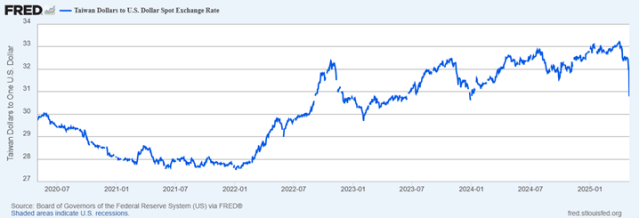Currency Coordination Looks Riskier Today
The Taiwan dollar’s rapid appreciation in the second quarter led to speculation of a “Plaza Accord 2.0” — a coordinated effort to weaken the US dollar — echoing the historic 1985 agreement among G5 nations. The original Plaza Accord was designed to address large US trade deficits by engineering a controlled depreciation of the dollar through joint currency intervention. It marked a rare and powerful example of global currency coordination. Any new Plaza-style agreement today would face far greater financial and geopolitical hurdles than it did 40 years ago. Indeed, if US policymakers seek to stimulate domestic manufacturing by depreciating the dollar, they must also account for the emerging costs and risks associated with global trade, capital flows, and market stability. This post examines the potential consequences of a coordinated dollar depreciation today — from FX volatility and insurance risk to broader macroeconomic impacts. A Weaker Dollar Could Heighten Global FX Volatility A weaker US dollar could have a dramatic effect on the FX market and, specifically, on Taiwanese life insurance companies. A January 2025 FT article pointed out that these companies hold assets equivalent to 140% of Taiwan’s GDP. A substantial portion of these holdings are in US-dollar-denominated bonds only partially hedged for FX volatility. Taiwan has enjoyed widening current account surpluses due in large part to strong demand for its semiconductors. To manage the resulting FX reserve growth and to maintain FX stability, the local monetary authority permitted life insurance companies to swap their Taiwan dollars for US dollars in the FX reserve. The insurers then swapped USD to buy US fixed-income assets to meet future (insurance policy) obligations. Despite shifting the bulk of their portfolio assets to US dollars, most of the insurance policies (firm liabilities) remain denominated in local currency. The result would be a significant currency mismatch where sharp declines in the US dollar would reduce the value of US-dollar-denominated bonds such as US Treasuries held by Taiwanese insurance companies, leaving the insurance companies with insufficient assets to match their liabilities. The original Plaza Accord signed by the G-5 countries in 1985 was agreed upon under the backdrop of a relatively benign macro environment. A hypothetical “Plaza Accord 2.0” to depreciate the US dollar would likely increase pressure on Taiwan’s insurers and their risk-management efforts. This vicious cycle would exacerbate pressure and magnify FX market volatility. Taiwanese insurance companies are also exposed to duration risks. The US dollar bonds held by Taiwanese insurance companies are longer-duration (with greater interest rate sensitivity than short-maturity debt). Sales of these assets would likely lift long-term US interest rates and transmit interest rate volatility across markets. Taiwanese insurers are not alone in their exposure to this type of risk. Similar carry-trade flows (sell local currency, buy US dollar and dollar-denominated assets) with the Japanese yen in the third quarter of 2024 triggered a brief-but-disruptive volatility surge across major asset markets. The US Trade Deficit’s Hidden Role A “Plaza Accord 2.0” coming 40 years after the original accord would need to account for the US trade deficit as part of a circular currency flow to fund the US government. In 1985, the US deficit was at $211.9 billion. By 2024 it had risen to $1.8 trillion. Similarly, the US debt ballooned from $1.8 trillion in 1985 to $36.2 trillion in the second quarter this year. Non-US exporters reinvesting trade surplus dollars in US Treasuries (lending surplus dollars back to the US government) are a key source of liquidity in the US bond market: Under the present paradigm, a lower US trade deficit would likely disrupt the reinvestment of exporter dollar trade surpluses, which could reduce foreign demand at US Treasury auctions and negatively affect secondary market liquidity conditions. “Plaza Accord 2.0’s” Nuanced Impact On a Leaner US Manufacturing Sector The US manufacturing sector has evolved significantly over the past 40 years. According to BEA data, the US manufacturing sector’s share of nominal GDP fell to 9.9% in 4Q 2024 from 18.5% in 1985.The total number of workers in the manufacturing sector also declined. In April 1985, manufacturing employees as a share of total non-farm payrolls was 18.4%. By April 2025, that number had dropped to 8.0%. The reduction in manufacturing headcount (with improved productivity, until gains began to stagnate in the late 2000s) implies US manufacturing had become more efficient between 1987 and 2007: Thus, a changed manufacturing industry with relatively smaller payrolls now than in 1985 would likely benefit differently from impacts of Plaza style accords than four decades ago, when more households were directly participating in the industry. Assessing the Risk Reward of “Plaza Accord 2.0” Studies on the impact of the original Plaza Accord concluded that exchange rate shifts ultimately led to changes in trade balances with a lag of two years. A similar lag would likely apply today, raising questions about whether a new Plaza-style intervention could meaningfully support US manufacturing — now a leaner, smaller share of GDP — without triggering broader financial disruptions. Compared to 1985, today’s global system is more interconnected and more reliant on the dollar, particularly through foreign holdings of US debt. Any coordinated effort to weaken the dollar would need to balance potential industrial gains against risks to FX stability, institutional asset-liability mismatches, and the functioning of US debt markets. The cost-benefit equation for “Plaza Accord 2.0” is far more complex than it was four decades ago. Calls for a “Plaza Accord 2.0” reflect growing concern over US trade imbalances and industrial competitiveness. But unlike in 1985, the global economy today is more complex, with deeper interdependencies and more fragile financial linkages. A new Plaza-style agreement would carry unintended consequences — from FX volatility and insurance-sector risk in Asia to disruptions in US debt financing and monetary policy transmission. Under the original Plaza Accord, currency shifts took years to influence trade balances, underscoring the lag between intervention and impact. Policymakers must therefore assess whether the benefits to a leaner US manufacturing base would outweigh the risks to global markets, institutional stability,
Currency Coordination Looks Riskier Today Read More »













